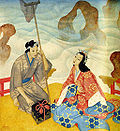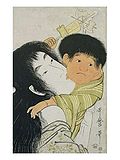- Nine-tailed fox
-
The Nine-tailed fox is a mythological creature that has the appearance of a fox but with nine tails. This mythological creature was first created in Asia (China, Korea, Japan).
Contents
Mythology
Nine-tailed fox, or Jiǔwěihú (九尾狐) is a mythological creature species that was depicted in the Nanshan jing, Haiwaidong jing and Dahuangdong jing of Shan Hai Jing to have a voice of a human infant. It can be eaten by human, and those who eat it can be protected from evilness.[1]
Later in some history books like Book of Zhou and story collection like Extensive Records of the Taiping Era, the nine-tailed fox was depicted to be a beast of fortune. Sent by the heavens, the nine-tailed fox was seen as a sign of fortune, peace and luck. In the Han dynasty, it is the protector of the royal blood. However, it can also represent an omen of revolution when the emperor is not good.
It was said to have possessed Mei Xi(妹喜), bewitched Jie of Xia and caused the downfall of the Xia dynasty. This story, which appear after the story of Daji, however, was very similar in nature to the story of Daji, and thus received critics stating the later writers only plagiarized earlier folklore or the telling of the stories was modified to discredit different dynasty. The torture and creations of Mei Xi were very similar to those of the creations of Daji but those were first used in Zhou dynasty with little historical evidence dating those back to Xia.
The nine-tail fox appeared in the epic fantasy novel Fengshen Bang as a Yaojing, or spirit, controlled by the deity Nüwa and was ordered to bewitch King Zhou of Shang in the 11th century BC. The fox possessed the body of Daji and did her bidding. Daji was eventually killed by Jiang Ziya and the fox was condemned by Nüwa due to the fox's cruelty and disobeyed its original order of bewitch King Zhou but do not harm others towards the end of Fengshen Bang.
In later stories, a nine-tailed fox was blamed for possessing Baosi like Daji and caused the downfall of Western Zhou, forcing the dynasty moving its capital and establish the Eastern Zhou period.
Tamamo-no-mae
Tamamo-no-Mae written/collected in the Otogizōshi of the Muromachi period, also mentioned by Toriyama Sekien in Konjaku Hyakki Shūi. Tamamo-no-Mae was a courtesan under the Japanese Emperor Konoe, she was praised to be the most beautiful and intelligent woman. She caused the Emperor to be extremely ill and was chased away by Abe no Yasuchika, who was called to diagnose the reason of the Emperor's poor health, and discovered the true nature of Tamamo-no-mae. A few years later, in the area of Nasu, the nine-tailed fox was seen killing and eating women and travelers, Emperor Konoe thus sent Kazusa-no-suke and Miura-no-suke along with 80,000 troops to kill the fox. In the plains of Nasu, it was finally killed and became a stone called Sessho-seki that continued to release poisonous gas and kill everything that contacts it. The stone was said to have been destroyed in the Nanboku-chō period by Gennoh Shinshou and the pieces flew away to different parts in Japan.
Hokusai's depiction
In the story told by Hokusai, formed in the Edo period, the nine-tail fox which possessed Daji was not killed, but instead fled to Magadha of Tianzhu (ancient India) and became the concubine of a prince there, causing him to cut off 1000 men's heads. It was then defeated again, and fled the country.
In around 780 BC, the same fox was said to have possessed Baosi (see above) and again chased away by human military forces.
The fox stayed quiet for some period. In AD 753, changed into the form of a 16, 7 year old girl named Wakamo, fooled Kibi Makibi, Abe no Nakamaro and Jianzhen and boarded the ship of the 10th Japanese missions to Tang China when it is about to return to Japan.
In 1113, a samurai called Sakabe Yukitsuna (坂部行綱) with no children picked up an abandoned baby girl Mizukume (藻女, girl of algae) which was actually the nine-tailed fox's transformed, and raised her for 17 years. At the age of 18, she changed her name to Tamamo-no-Mae, entered the palace and bewitched Emperor Konoe.(see above)
References
- ^ 『山海經』南山經, 又東三百里,曰青丘之山,其陽多玉,其陰多青䨼。有獸焉,其狀如狐而九尾,其音如嬰兒,能食人;食者不蠱。wikisource
See also
Japanese folklore 
Folktales 
Text collections Legendary creatures Categories:- Chinese mythology
- Asian legendary creatures
- Mythological canines
- Fictional foxes
Wikimedia Foundation. 2010.
